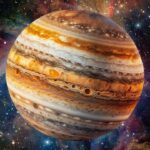AG Carinae, a luminous blue variable star, has been under NASA’s radar, capturing the final acts of its life through stunning images. The NASA Hubble Space Telescope recently unveiled a comparison of two images showcasing puffing dust bubbles and an erupting gas shell surrounding AG Carinae. This star, formally classified as a Luminous Blue Variable, emits blue light and varies in brightness, making it a rare and massive celestial entity.
The images reveal details of ionized hydrogen and nitrogen emissions from the expanding shell of the nebula surrounding AG Carinae, with the second image highlighting the distribution of dust that reflects starlight in a striking blue hue. Scientists believe that powerful stellar winds emanating from the star have contributed to the formation and shaping of the dust bubbles and filaments within the nebula, which spans about five light-years – akin to the distance to Proxima Centauri, the nearest star beyond the Sun.
AG Carinae is engaged in a fascinating cosmic tug-of-war between gravity and radiation pressure as it nears the end of its life cycle. As the star depletes its fuel, its radiation pressure decreases, allowing gravity to take hold and initiate the explosive ejection of stellar material into the interstellar space surrounding it, forming the captivating nebula showcased in the images. Remarkably, the nebula, which is approximately 10,000 years old, exhibits a velocity of gas at around 43 miles per second.
Moreover, the stunning images captured by NASA’s Hubble Space Telescope elucidate the intricate structure of the nebula surrounding AG Carinae, signifying the star’s eventful past outbursts through the formation of clumps, bubbles, and filaments of dust shaped by the intense stellar wind. The non-spherical shape of the nebula, displaying bipolar symmetry, hints at multiple dynamics at play, suggesting the involvement of a disk in the center or a potential binary star scenario.
Overall, the breathtaking revelations of AG Carinae by the NASA Hubble Space Telescope provide a rare glimpse into the dramatic final stages of a massive, luminous star, adding to the rich tapestry of cosmic wonders observed and documented by humanity’s advancements in space exploration and astronomical research.







